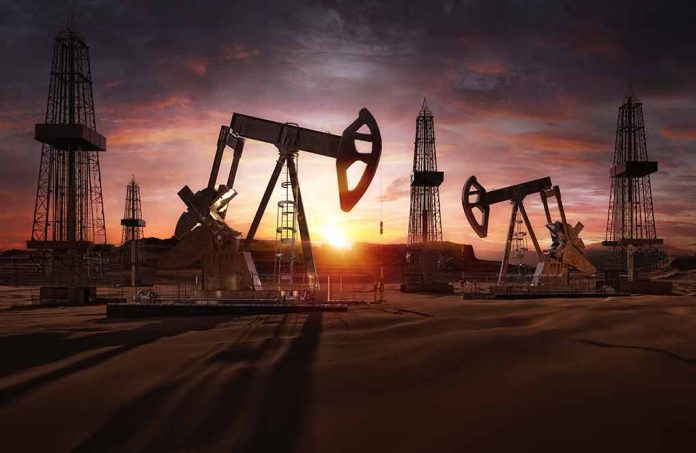
The Keystone Pipeline, a critical artery for Canadian oil transport to the United States, was suddenly shut down after a rupture in North Dakota, raising questions about energy security and environmental impact while reviving debates about pipeline expansion projects.
Key Takeaways
- A pipeline rupture heard as a “bang” and followed by a pressure drop led to an immediate shutdown of the Keystone Pipeline in North Dakota.
- Oil released into an agricultural field near Fort Ransom has been contained, with no reported impacts to nearby streams, people, or structures.
- The pipeline, completed in 2010 at a cost of $5.2 billion, normally transports 624,000 barrels of Canadian crude oil daily to U.S. refineries.
- This marks at least the fourth significant spill from the Keystone system since 2017, with the largest occurring in Kansas in 2022.
- The incident reignites discussion about the canceled Keystone XL expansion project, which President Biden halted in 2021 despite projections it would create over 42,000 jobs and contribute $3.4 billion to the U.S. economy.
Sudden Shutdown After “Mechanical Bang”
The Keystone Pipeline was abruptly shut down when a sudden rupture was detected near Fort Ransom, North Dakota. The incident began when an employee at a pump station heard what officials described as a mechanical noise. According to Bill Suess, spill investigation program manager with the North Dakota Department of Environmental Quality, “An employee on a pump station heard what was described as a mechanical bang,” described Suess. This alert, combined with a sudden pressure drop detected by the control center, triggered immediate emergency shutdown procedures at milepost 171 of the pipeline system.
South Bow, the company that has managed the pipeline since early 2024, quickly activated their emergency response protocols. The company reported they made “appropriate notifications to our regulators, landowners and customers.” Investigation teams are now working to determine both the cause of the rupture and the total volume of oil released, though officials believe this spill will not reach the magnitude of previous incidents. Fortunately, the spill was contained to an agricultural field, with no reported impacts to water sources, residential areas, or public infrastructure.
BREAKING NEWS:
The Keystone Pipeline has RUPTURED.
Oil spill near Edinburgh, North Dakota after rupture of Keystone pipeline. pic.twitter.com/ScJbcKc98b
— Mila Joy (@MilaLovesJoe) April 9, 2025
Pipeline History and Previous Incidents
The Keystone Pipeline, which began operations in 2011, represents a major energy infrastructure investment, costing $5.2 billion to complete. The system stretches from Alberta, Canada, across U.S. states including North Dakota, South Dakota, Nebraska, Kansas, Missouri, Illinois, and Oklahoma. Prior to this incident, the pipeline was transporting approximately 624,000 barrels of Canadian crude oil daily to American refineries, serving as a vital energy conduit between the two nations.
This rupture marks at least the fourth significant spill from the Keystone system since 2017. The most substantial incident occurred in December 2022 in Kansas, where approximately 13,000 barrels of crude oil were released. Other notable spills include a 2017 incident in South Dakota and a 2019 release in North Dakota’s Walsh County. The North Dakota Department of Environmental Quality is now overseeing remediation efforts for this latest spill, coordinating with South Bow to ensure proper cleanup and environmental restoration of the affected agricultural land.
Keystone XL Controversy Revived
The current pipeline incident has rekindled discussions about the controversial Keystone XL expansion project, which was permanently canceled in 2021 by President Joe Biden. The proposed expansion would have significantly increased transport capacity, adding the ability to move an additional 830,000 barrels of crude oil daily from Canada’s oil sands to Gulf Coast refineries. The project faced fierce opposition from environmental groups but had strong support from energy industry advocates and many lawmakers.
Economic analysis from 2014 projected that the Keystone XL would have generated approximately 42,100 jobs during construction and contributed $3.4 billion to the U.S. GDP. Additionally, the project was expected to generate $55.6 million in annual property tax revenue across Montana, South Dakota, and Nebraska. President Donald Trump has repeatedly called for the project’s revival, and Canadian officials expressed disappointment when it was terminated, citing lost economic opportunities for both nations and concerns about less efficient oil transport methods.
The current pipeline shutdown, while temporary, highlights America’s continuing reliance on Canadian oil imports and the ongoing debate about the most effective and secure methods for transporting energy resources. While cleanup efforts are underway in North Dakota, broader questions about energy infrastructure, environmental safeguards, and North American energy independence remain at the forefront of public discourse.
Sources:
Keystone oil pipeline shut down after “mechanical bang” reported
Keystone pipeline shut down after rupture
Keystone pipeline shut down after rupture, oil spill contained







